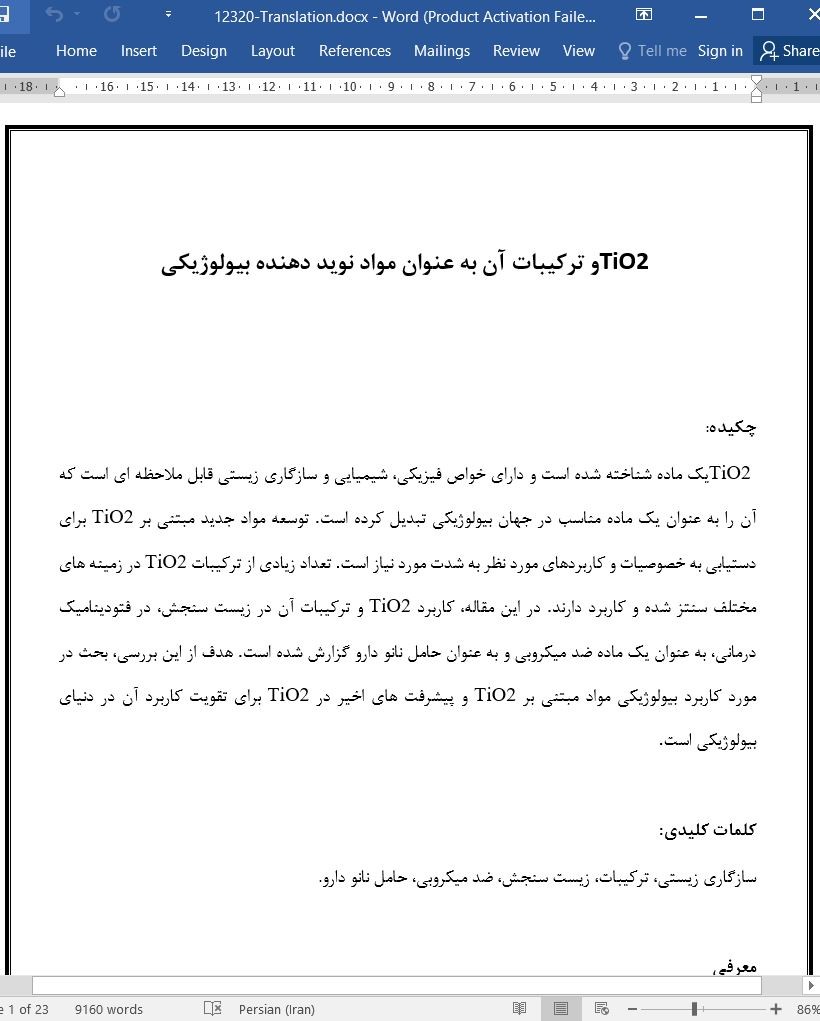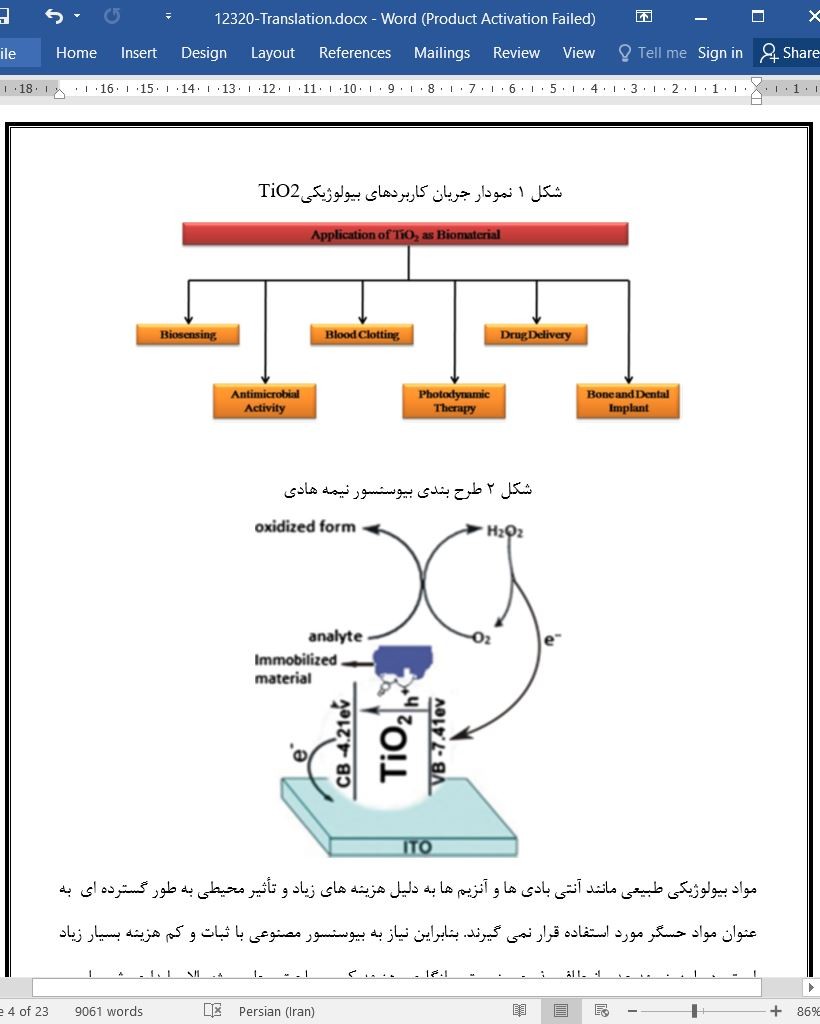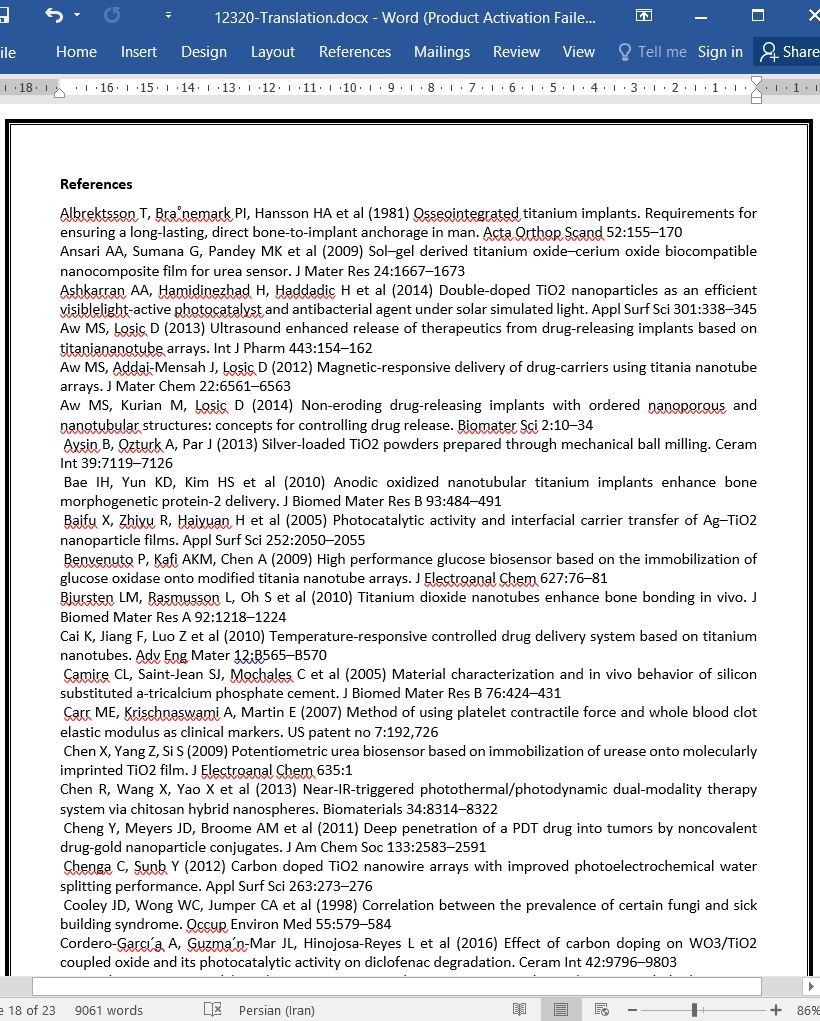
TiO2 و ترکیبات آن به عنوان مواد نوید دهنده بیولوژیکی
چکیده
TiO2 یک ماده شناخته شده است و دارای خواص فیزیکی، شیمیایی و سازگاری زیستی قابل ملاحظه ای است که آن را به عنوان یک ماده مناسب در جهان بیولوژیکی تبدیل کرده است. توسعه مواد جدید مبتنی بر TiO2 برای دستیابی به خصوصیات و کاربردهای مورد نظر به شدت مورد نیاز است. تعداد زیادی از ترکیبات TiO2 در زمینه های مختلف سنتز شده و کاربرد دارند. در این مقاله، کاربرد TiO2 و ترکیبات آن در زیست سنجش، در فتودینامیک درمانی، به عنوان یک ماده ضد میکروبی و به عنوان حامل نانو دارو گزارش شده است. هدف از این بررسی، بحث در مورد کاربرد بیولوژیکی مواد مبتنی بر TiO2 و پیشرفت های اخیر در TiO2 برای تقویت کاربرد آن در دنیای بیولوژیکی است.
معرفی
مواد بیولوژیکی مواد زیست سازگار هستند که در دنیای بیولوژیکی برای تجزیه و تحلیل، درمان و پشتیبانی از موجودات زنده مورد استفاده قرار می گیرند. آنها ممکن است منشاء طبیعی داشته باشند یا در آزمایشگاه سنتز شوند. در بین مواد سنتز شده، TiO2 یکی از مواد نیمه رسانا شناخته شده است که در دنیای بیولوژیکی مورد استفاده قرار می گیرد(TiO2 دی اکسید تیتانیوم یا تیتانیوم 4 اکسید می باشد که کاربرد های وسیعی دارد). استفاده از TiO2، در شکافتن آب (Fujishima and Honda 1972) و در کشتن میکروارگانیسم های مختلف توسط پرتوهای فوتو (Matsunaga et al. 1985)، تا حدود زیادی جهان شیمیایی و بیولوژیکی را متحول کرد( در پدیده ی شکافتن آب، مولول آب به دو ماده ی اکسیژن و هیدرژن شکافته می شود). در حال حاضر TiO2 به طور گسترده ای در لوازم آرایشی، رنگ، سرامیک، فوتوکاتالیز، سلول خورشیدی، رنگ آمیزی مواد غذایی و غیره مورد استفاده قرار می گیرد.
نتیجه گیری
TiO2 و ترکیبات آن از پایداری بالا ، خواص زیست سازگار و شکاف باند مناسب برخوردار هستند، از این رو به طور گسترده به عنوان ماده بیولوژیکی مورد استفاده قرار می گیرند. الحاق فلز، غیر فلز و سایر اکسیدهای فلزی با TiO2 باعث افزایش پایداری آن و کاهش شکاف باند شده و کاربرد آن را در دنیای بیولوژیکی را بهبود می بخشد. واکنش سریع در برابر سنجش ترکیبات بیولوژیکی و فعالیت ضد میکروبی خوب آن به دلیل شکاف باند و توانایی جداسازی بار آن بود. فاز آناتاز نقش مهمی در فعالیت ضد میکروبی دارد، در حالی که فاز روتیل در لانه گزینی کمک می کند. مساحت سطح بالا و ساختار متخلخل، آن را به عنوان یک حامل دارویی مؤثر می سازد و ترکیبات آن با مواد قابل تغییر می باشد که برای استفاده از آن به عنوان ماده درمانی فوتودینامیکی است.
Abstract
TiO2 is a well-known material and has remarkable physical, chemical and biocompatible properties which have made it a suitable material in the biological world. The development of new TiO2- based materials is strongly required to achieve desired properties and applications. A large number of TiO2 composites have been synthesized and applied in various fields. The present review reports the utility of TiO2 and its composites in biosensing, in Photodynamic Therapy, as an antimicrobial agent and as a nanodrug carrier. The aim of this review is to discuss the biological application of the TiO2 based materials and some recent advancement in TiO2 to enhance its application in the biological world.
Introduction
Biomaterials are biocompatible substances used in biological world for analysis, treatment and support to the living beings. They may be originated naturally or synthesized in laboratory. Among synthesized materials, TiO2 is one of the well-known semiconductor material used in the biological world. Utilization of TiO2, in water splitting (Fujishima and Honda 1972) and in photokilling of various microorganisms (Matsunaga et al. 1985) revolutionized the chemical and biological world respectively to a great extent. In the present scenario TiO2 is widely used in cosmetics, paints, ceramics, photocatalysis, solar cell, food coloring etc.
Conclusion
TiO2 and its composites exhibit the high stability, biocompatible properties and suitable band gap, hence widely used as biomaterial. Introduction of metal, nonmetal and other metal oxide with TiO2 further improves its application in the biological world by enhancing its stability and reducing the band gap. Fast response towards the sensing of the biological compounds and good antimicrobial activity was highly thanks to its band gap and charge separation ability. Anatase phase plays major role in the antimicrobial activity while rutile phase helps in the implantation. High surface area and porous structure makes it as effective drug carrier and its compounds with the upconversion materials promote for its use as photodynamic therapeutic agent.
چکیده
معرفی
سنجش زیستی
فعالیت های ضد میکروبی
لخته شدن خون
درمان فوتو دینامیک (PDT)
تحویل دارو
ایمپلنت های استخوان و دندان
نتیجه
منابع
Abstract
Introduction
Biosensing
Antimicrobial activity
Blood clotting
Photo dynamic treatment (PDT)
Drug delivery
Bone and dental implantation
Conclusion
References
- اصل مقاله انگلیسی با فرمت ورد (word) با قابلیت ویرایش
- ترجمه فارسی مقاله با فرمت ورد (word) با قابلیت ویرایش، بدون آرم سایت ای ترجمه
- ترجمه فارسی مقاله با فرمت pdf، بدون آرم سایت ای ترجمه



